Azerbaijan is not easily classified. The local Caucasus avant-garde includes ancient towers, fortifications, castles and traditional homes mixed with architecture straight out of Stanislaw Lem’s sci-fi novels and movies. All that intertwined with hints of prehistoric influences, stunning landscapes and fabulous foods, prepared by friendly locals.
For years on end, Azerbaijan was always at the tail-end of the Caucasus wish list for Polish tourists, considering how hard it was to get visas and the high cost of staying in the beautiful, majestic capital city, kept in fine Art Nouveau style and sandstone colours. Today, visas can be arranged over the internet, and the whole thing takes less than a day to process. The prices in Baku have also dropped, though still higher than in other parts of the country. On the other hand, the experience of visiting Baku – the largest city in Azerbaijan, as well as being the lowest capital city in the world (28 metres below sea level) – is very much worth it.

Day 1. Baku – a journey into the future
The flight from Tbilisi to Baku only takes an hour. I make good use of this time, watching 40 minutes worth of the blockbuster Kong: Skull Island – to then get off the plane in a completely different dimension. The airport in Baku is an architectural hymn to a completely different future, one which Azerbaijan sang at full volume not that long ago. The feeling that I have landed on a different planet will not leave me for a while yet, but without giving too much away too early on, I collect my things and head for the centre of the capital.

Baku is a tastefully created mosaic of a world gone by, mixed together with a futuristic reality. Its Flame Towers shoot up over the old town – a symbol of the oldest port on the Caspian Sea shocking in its modernity. For the time being, they are the main example of the way this cities envisions itself in terms of architecture, but in time less ambitious projects are due to join them, including the national EXPO 2025 pavilion, built on a site shaped like an eight-pointed star – the national symbol of Azerbaijan – as well as a visually futuristic hi-tech housing-hotel-business complex which will use wind power to filter sea water, all for its own use. Seeing as Azerbaijan’s main aim at present is the building of a new and better future, it can be supposed that both projects will soon enough come to fruition. And yet, without having to wait that long, its clear the largest capital city in the Caucasus region already has a lot to offer.

In order to see it all with our own eyes, its best and cheapest to grab an Uber, the metro or a bus. My first evening here is limited to a shy bit of wandering round a city which is home to two million residents. From the metro, I go to grab a bite to eat, leaving the Baku Hard Rock Cafe with a new souvenir t-shirt. What more could anyone want?

Day 2. A Bit of Old Baku
All this modernity on offer is tempting, but first of all I set off in search of history. Although the first ever mention of Baku – the name deriving from the Persian word “badkube”, which means “wind strike” and is related to the strong winds this region is well known for – dating back to the 12th century, although archeological digs show the oldest part of town dates back to the 9th century AD.

One can spend a whole day exploring the famous Inner City İçəri Şəhər, which is what I have planned for today. It’s not hard to get lost in Baku’s old town, because… that was the intention of those who built it in the Middle Ages. The city, subject to constant attacks from all sides, defended itself by forming a real labyrinth of narrow alleyways and dead end streets – no army could squeeze through them, while soldiers walking in line made for easy targets.

In 2000, İçəri Şəhər was added to the UNESCO list of world heritage sites. I first came across descriptions of the city in Wojciech Górecki’s book Toasting the Ancestors, one I would heartily recommend. It is this book which helped me discover the secrets of old Baku, leading me down those cobblestone streets, basking in their magic atmosphere. It’s this clash of two worlds which makes the biggest impression on visitors – the stone Muhammed mosque (said to have been erected on the old site of the fire temple), decorated in painstaking fashion after the Friday mosque erected in 1899, the most modern sorts of cars parked outside it, the Flame Towers glowing overhead with steel and glass.

Walking along a broad high street, lined with sandstone buildings, I reach one of the most remarkable buildings in the Inner City: The Virgin Tower (Qız qalası, 12th century A.D.). Both the exact time of its erection and its purpose remain the subject of legend and unconfirmed speculations. Some researchers believe the lower section of the fortress was built between the 8th and 7th century Before Christ, while the upper section, surrounded with striped stones, is younger – confirmed by the discovery, on the upper tower, of script in Kufic writing from the 12th century, naming Kubej Masud ibn Da’ud the architect of the fortress’ reconstruction. According to certain opinions, the tower was, as early as the 4-6th century, a part of a Zoroastrian temple. According to other experts, it served as an astronomic observatory. The aforementioned inscription explains how – at least from the 12th century onwards – the citadel was inaccessible to invaders (housing a pantry, water well and shelter for up to 200 people). In the 19th century, the tower was used as a lighthouse, and as of 1968 it has housed a museum of the history and ethnography of Baku. It is said there is a tunnel leading from it, linking it with the Palace of the Shirvanshahs (15th century), which I was unable to find and enter, alas.
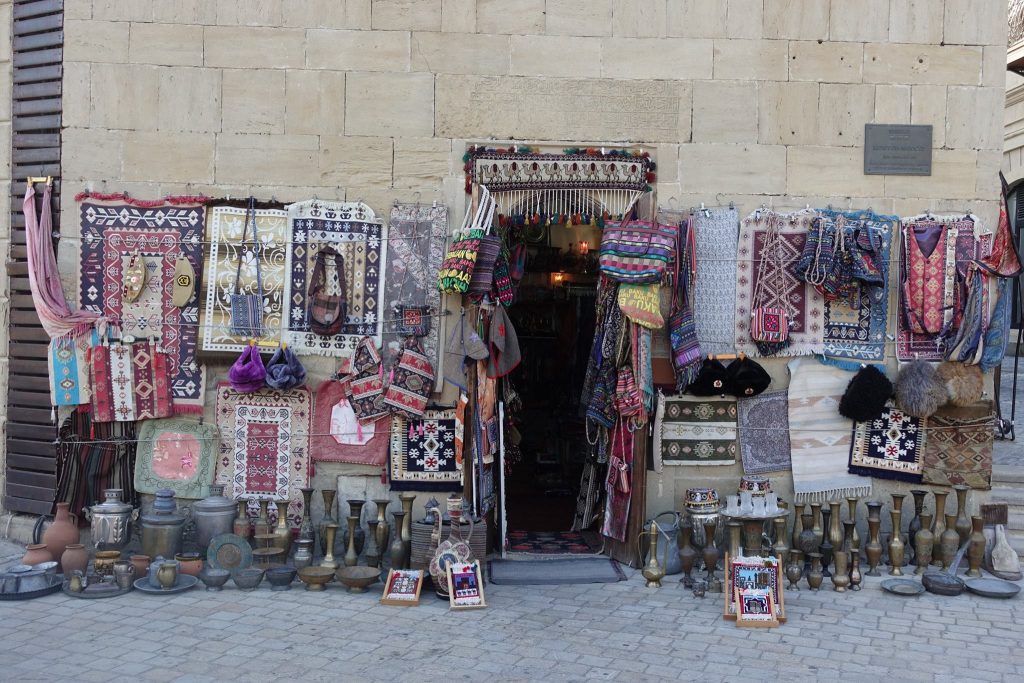
As I was wandering round the old streets of Baku, I came across a couple of sites related to Poland – the embassy, of course, but also – next door to a Rolls Royce dealership – I find a barber shop using BOND branded cosmetics products, which not that long ago were not taken seriously back home – and are now being used by haircare professionals in cities such as Krakow.

Knowing that the next day I would be escaping the city and going out to the wilds – one cannot live by urban landscapes alone! – I allow myself to indulge in some baklava (here called pahlava), shekerbura, which is a sweet bun with nuts, almonds and honey, as well as a lula kebab. Once it begins to get dark, I stroll the promenade along the Caspian Sea, to see the illuminated, modern city coming alive.






Day 3. Mighty nature – Gobustan National Park
Early morning, I go to visit Gobustan National Park (Qobustan Milli Parkı ). It is some 60kms from the capital, which is about an hour along the motorway. Along the way, I pass by modern hotels and luxury villas lining the Caspian Sea, some of the oldest oil fields around, dating back to the oil prospecting fevers of the 1880s, along with traces of settlers from Paleolithic and medieval times. Soon enough, bare mountains and sun-baked steppes tell me I am close.

I start at the Rock Art museum, which moved its building to a nearby steppe having been added to the UNESCO list in 2007. The ticket costs 9 AZN, allowing me to see a modern, multimedia exhibition, and then set off outside.


The severe, rocky vistas to be found in Gobustan National Park bring to mind Uplistsikhe, which is an ancient rock-hewn town in eastern Georgia. Yet while the latter is made by human hands, in Gobustan the rock formations are mostly natural, only mildly altered by human intervention. Among them, one finds 300 bubbling mud volcanoes (of the 700 to be found in the world as a whole), which spill their grey liquids on the dried and cracked earth. I observe this wild beauty, having climbed a mountain called Boyukdash.

My attention is above all drawn by the prehistoric Petroglyphs, of which there are a mere 6000! According to researchers, the symbols hewn into the rocks – dating back some 5 to 40 thousand years! – represent the way the world was seen back in those days. One of the Petroglyphs tells the story of how the sun at nights sails on a boat, in order to each morning appear in the east. Our Azerbaijani ancestors really did have a rich imagination!
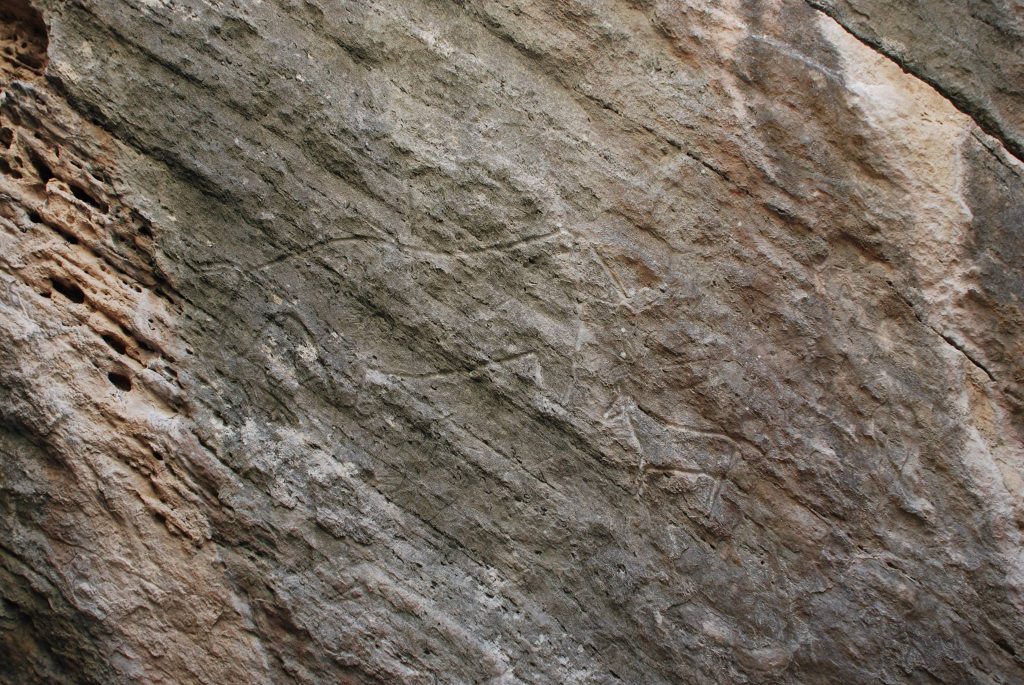
Gobustan National Park is also the only place in the world where one can find a musical rock – Gaval Dash. One can play it like a real instrument, hitting rocks against a surface worn away by centuries of concert performances. Depending on the size of the stones, one can achieve different tones, resembling those of a tambourine.

A less pleasing curio is the location of a nearby jail, where some 500 lifer prisoners are doing time. A sad spot on a lifeless piece of land, hiding some real treasures of history and nature too…

Day 4. Encountering the nation’s pride
I head back to Baku. The next absolute “must see” spot in Azerbaijan is the Heydar Aliyev Center, i.e. the Azerbaijani Culture Center. Named after the Azerbaijani politician and president (1993-2003), who is here treated with the same sort of love and respect as Atatürk in nearby Turkey.

All the Baku locals I talked to agree that Heydar Aliyev was one of the most important people in the history of Azerbaijan, responsible for setting the nation on its current course as the largest state in the Southern Caucasus region. Importantly, offending the president (worth mentioning: a former KGB agent) and his family carries financial penalties here – and can even land you in prison! Thus, one either praises or keeps silent about the man who did so much for his country.

The Heydar Aliyev Center is not just a place one can meet the former president. He looks down upon the city from billboards, posters and monuments, his name given to schools, libraries, government offices and the only one of its kind Hejdar Aliyev Foundation, which supports regional development. Locals speak with pride about how Hejdar Aliyev turned their city into what is now called “little Dubai”. Perhaps it is as a result of his father’s achievements that Ilham has now now become president (though not as feted as his father, at times accused of suppressing democracy), while the vice-president is his wife Mehriban, who is also the head of the aforementioned charity.
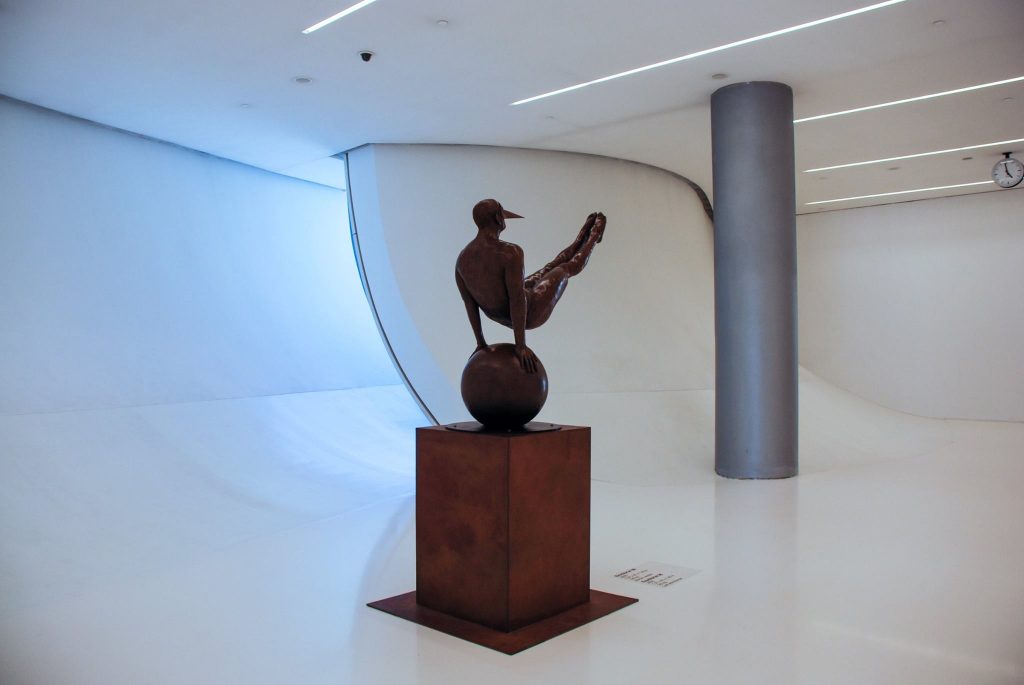
Hejdar Aliyev forced Azerbaijan onto new paths, so it is not surprising that the cultural centre named after him is a wonderful example of modern architecture, which in fact foretold a new, improved tomorrow. It is however shocking that the building of the center caused waves of protests relating to breaches of human rights, residents forcibly resettled and houses illegally knocked down, all in the name of this construction project. Dark secrets were swept under the rug, and the center – being a visible symbol of a moving away from the country’s Soviet past – was finally finished in the very heart of town. This futuristic, circular building, designed by the renowned Iraqi architect Zaha Hadid, looks like whipped cream. This graceful colossus, covering a surface of 100 thousand square metres, is truly remarkable both inside and out, being the venue for exhibitions, concerts and conferences.

I go through the contemporary arts exhibition (seasonal shows feature artists from all over the world – currently a Mexican sculptor). I then pop into the divan gallery, showing also traditional costumes and musical instruments – just standing in front of each exhibit has the relevant sounds playing automatically. I stop for a longer while by the display of government limousines. I am most interested in the ZIŁ 41047, mighty impressive set alongside various Mercedes Benzes. I also go to the concert hall and three floors of commemorative displays – featuring the president’s life, his achievements, garments and uniforms, along with all the gifts he received.


The Azerbaijani Culture Center is very modern and multimedia enabled. In one of the rooms, clicking on a globe produces a wall display of Hejdar Aliyev’s meetings with various presidents, including the Pole Aleksander Kwaśniewski. Next to the globe, I find an interactive book, its digital pages flipping with the lightest stroke of a fingertip. Everything – the lights, music, including the impressive presentations and video recordings – is thought and laid out in a way which arouses the emotions. This is the most interesting museum I have ever been in. The building itself also leaves an indelible impression – being one of the symbols of the city and frequent backdrop for wedding photos – in just one hour, I had managed to count up to a dozen of these!


Day 5. Trail of fire (At şgah, Yanar Dag and Shahidlar)
The next day can be summarised rather quickly: hot, hot all over the Caucasus region! Sweltering temperatures, instead of knocking me off my feet, lead me straight to a meeting with the incredible histories of Azerbaijani faiths. Currently, the country is dominated by Islam, though in the past it was home to early Christians (Caucasian Albania), and earlier than that – by Zoroastrists, the oldest monotheistic religion in the world, worshipping the god Ahura Mazda. The symbol of this religion is eternal fire, related to the Persian name for Azerbaijan – Âzarâbâdagân. This can be translated as the Land of Eternal Fire. One can follow religious doctrine or else not, but there can be no doubt that Azerbaijan is filled with surprising natural treasures: gas resources burning for thousands of years, which cannot always be explained.
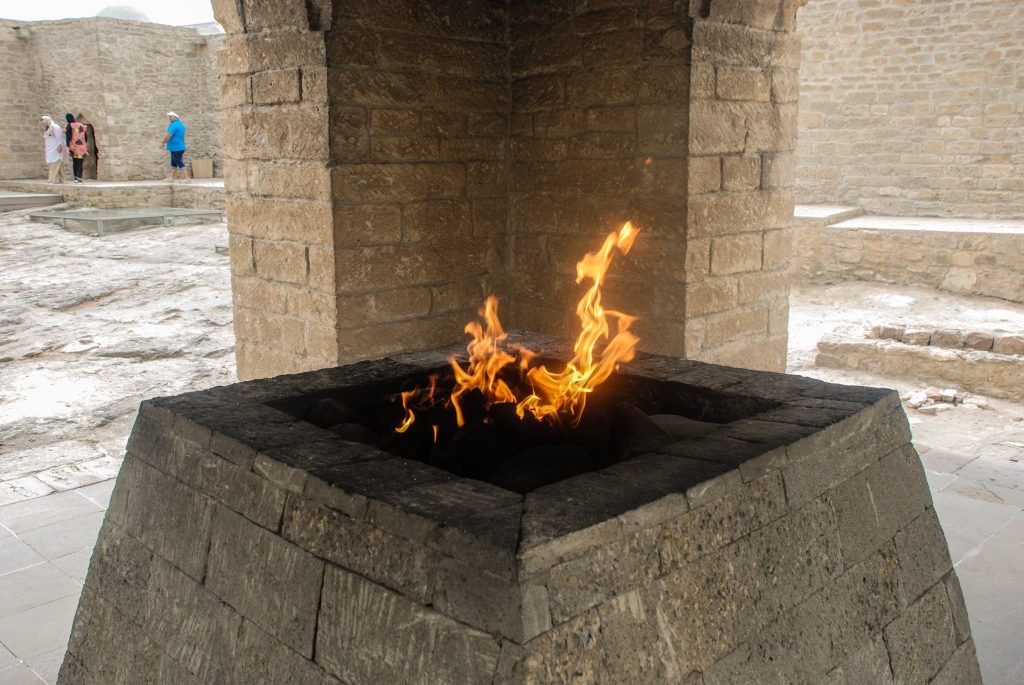
In order to discover Azerbaijan’s religious secrets, I travel to At şgah – located on the Apszeron Peninsula, not far from Baku, this Zoroastrian temple, previously also used by Hindu worshippers, seems to have been a place of fire worship ever since the 7th and 8th centuries A.D.. The existing buildings originate from the 18th century, and were erected by Hindus who had settled in the Caucasus region. In rooms which surrounded eternal fires, and were once upon a time used as Caravanserai (roadside inns for caravan parties to stop at), I look at images of scenes from temple life, as well as inscriptions dedicated to Hindu gods. According to lore, gas supplies at the temple ran out a long time ago, while the fires have been going thanks to a gas pipeline. No new religious ceremonies take place here today – the place functions solely as a museum, which I believe must be seen to be believed.

Things are somewhat different in Yanar Dag, a place I felt most moved by… that was until I actually got there. It takes around 45 minutes to get there from Baku – a place where fire was also venerated, but – best of all – it has been burning here for at least 4000 years now, without any refills or supplies!!! Unfortunately, it does seem that ancient sites appear best at a distance, lacking much when seen close up. This is also true of Yanar Dag, a little bit of burning deposits, surrounded by small villages and old factories. I am pleased to have visited it, but the visit at the time of happening was a letdown – or else my hopes were raised too high.

Having completed my fiery trail, I head back to Baku. Looking for photo opps, I go to the lush green Shahidlar – a cemetery and monument dedicated to the events of Black January in 1990. It is not easy to just pass by a place which even today causes powerful controversies, related to the victims of the Azeri-Russian-Armenian conflict, caused by very tense relations in the Nagorno-Karabakh region. Formally, it is part of Azerbaijani territory, but is in fact settled by Arminian nationals. Each side involved in the conflict believes fault lies on the other side. Azerbaijan blames Armenia, Armenia blaming Azerbaijan – a vicious circle. Shahidlar, home to the monument of Eternal Fire, arouses odd emotions, soothed somewhat by the most beautiful panorama the city presents visitors with. The view of the Flame Towers is breathtaking – these hotels, apartment and office buildings all in one – the tallest structures in Azerbaijan.
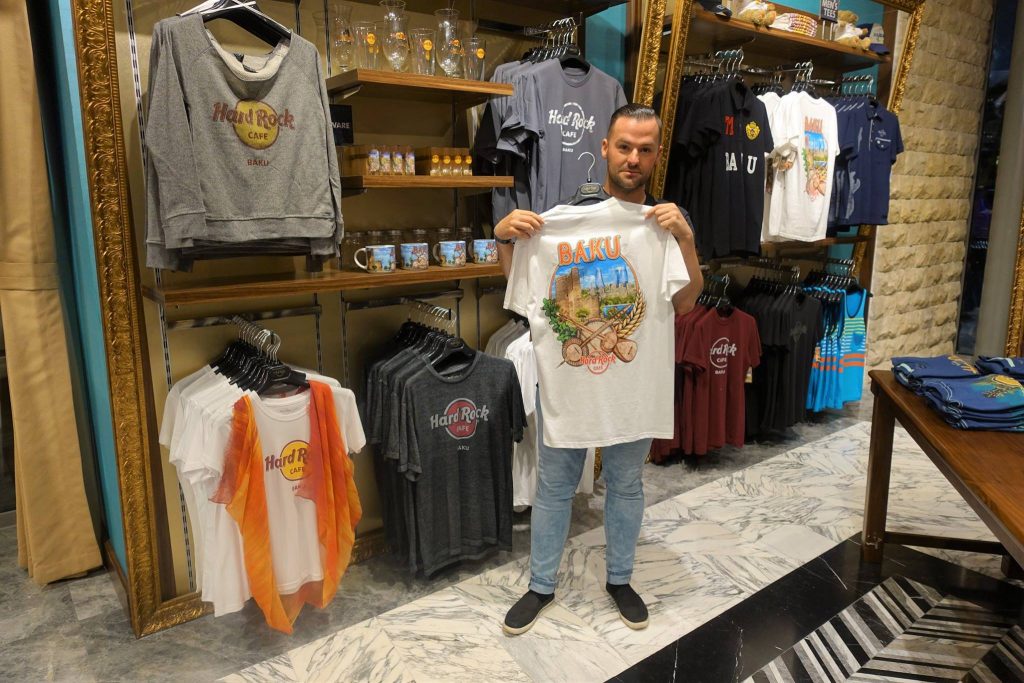
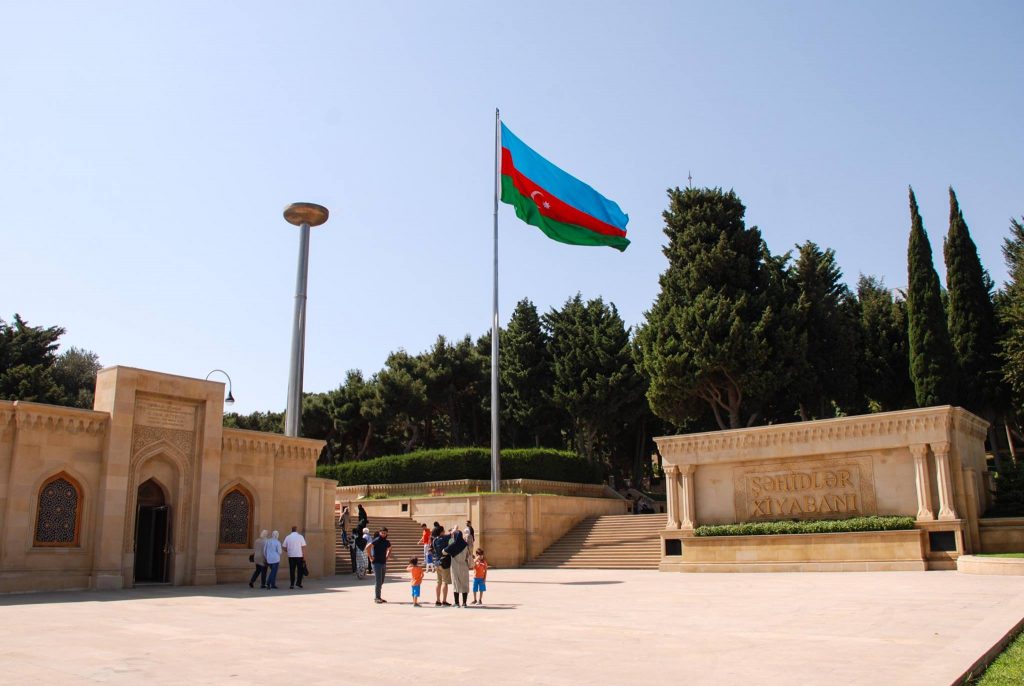
I look out across the city and know that 5 days is not enough to see all of Azerbaijan – far too little, just as 10 years is still not enough for me to get to know and fully describe Georgia. This is why next year I plan to once again make the Caspian Sea my destination. The wealth of impressions, thousands of years of history, friendly people (some warned me that Azerbaijani folks are not as friendly and warm as Georgians, but I am of a very different opinion), delicious foods and incredible views are that which I am looking for in the Caucasus, which I find in many of its corners and always wish to return to.


Practical information
FOOD PRICES – dinner for 2-3 can vary in the city centre, from 24 to 100 AZN!
SOUVENIR PRICES – fridge magnets starting at 1 AZN, printed canvas souvenir bags, starting at 8 AZN. It’s also worth bringing back teas, wines and pomegranate juice, all delicious.
SAFETY & SECURITY – Baku is safe and calm, the only “incursions” being flirtatious approaches from tourists from… Dubai, Borat style “yakshemash”. Baku residents dislike this, one can feel it when walking around town.
TAXI CABS – Uber wins in all cases, English style cabs being the most expensive (here ever since Eurovision 2012).
CATS – there are thousands of cats in Baku, all of them beautiful enough to want to take them home
WI-FI – abundant in hotels and restaurants, though it is worth buying a local operator card and using it during your stay.
AIRPORT – one of the most impressive airports I have ever been to, easily accessed by motorway, check-in being quick and efficient. Uber from the centre costs from 10 AZN.
REGISTRATION – if you are staying for more than 10 days, you have to register with the authorities. Hotels will make you aware of this, and sort everything for you, but this is not always true of hostels and guesthouses. Penalty for failing to register costs an eye-watering 200 USD!!! I have met people who have had to cough this sum up…
VISA – in less than 24 hours (https://evisa.gov.az/en/), just take care scanning your passport: make sure it is the page with your photo
TRICKY TOPICS – religion and the president Heydar Aliyev. Best be careful, as it is easy to cause offence.
WHAT TO WATCH OUT FOR – the police give fines for crossing roads in illegal places, and tourists pay on the spot. Do not fear underground pedestrian crossings, especially in central Baku they are beautiful and attractive to tourists!
WEATHER – August in Azerbaijan is even warmer than Georgia, temperatures reaching 40°C. Your comments suggest the city is drowning in smog, but I could not feel that – though I don’t come from anywhere near Krakow.
FILMING AND PHOTOGRAPHY – we tried not to film locals, as some made it clear they did not fish to be captured on film.


Any time now, we will be visiting Armenia. Considering the tense standoff between Armenia and Azerbaijan, I am a little worried we might encounter problems at the border (I have already changed my passport once this year – it contained stamps from Armenia, and I was going to Azerbaijan). Keep your fingers crossed for a smooth passage!


